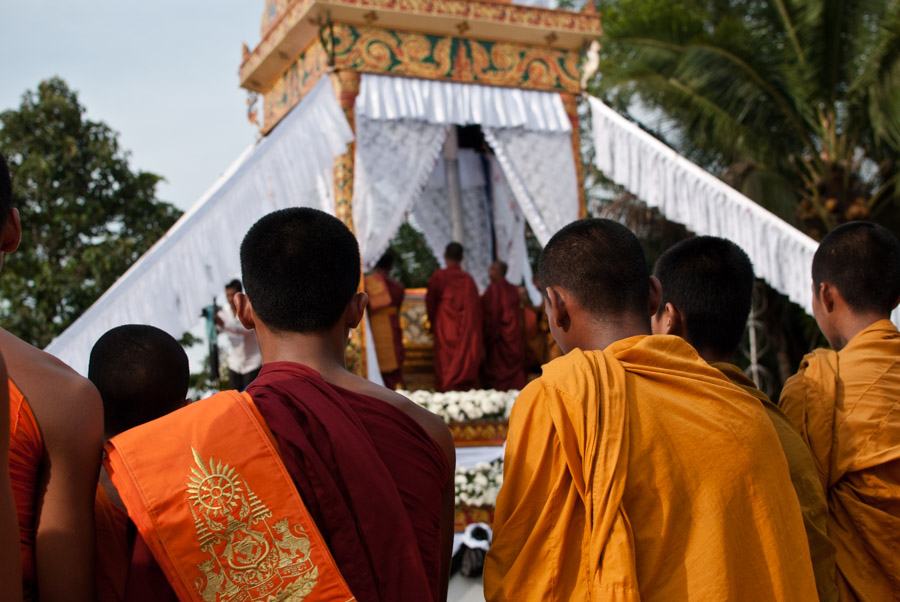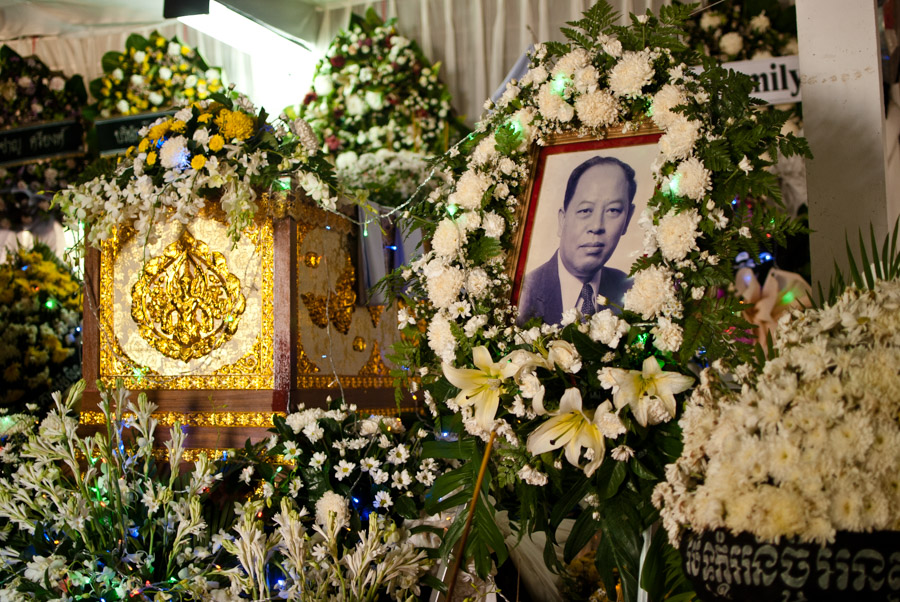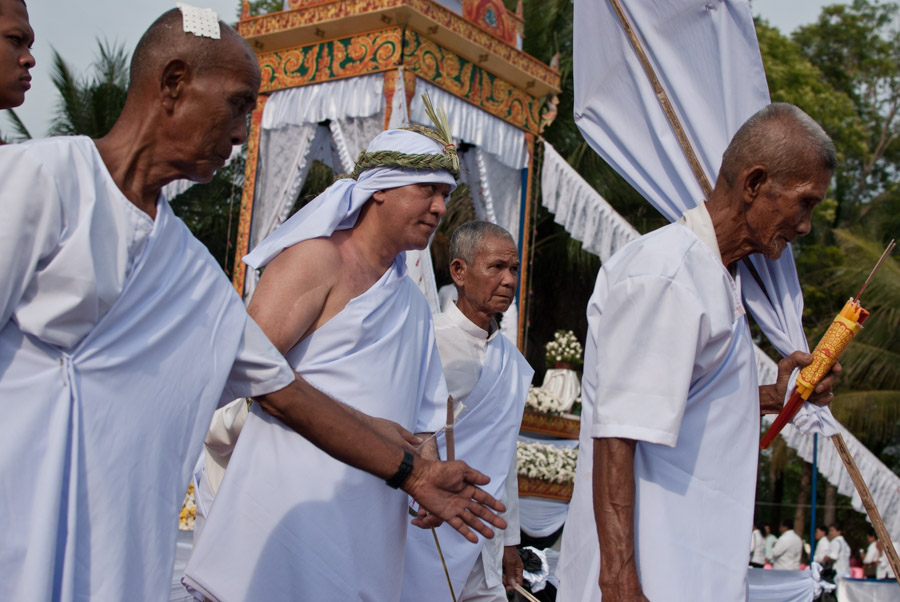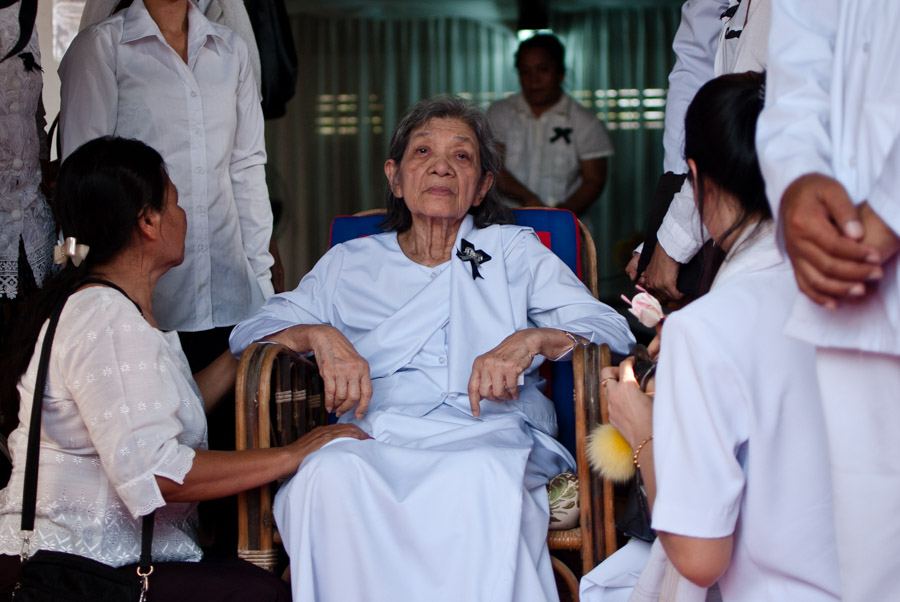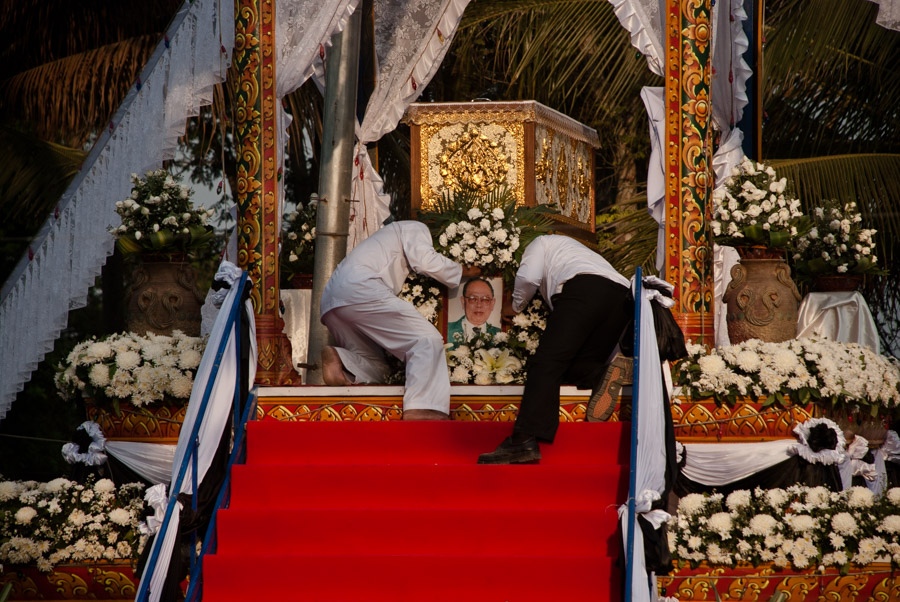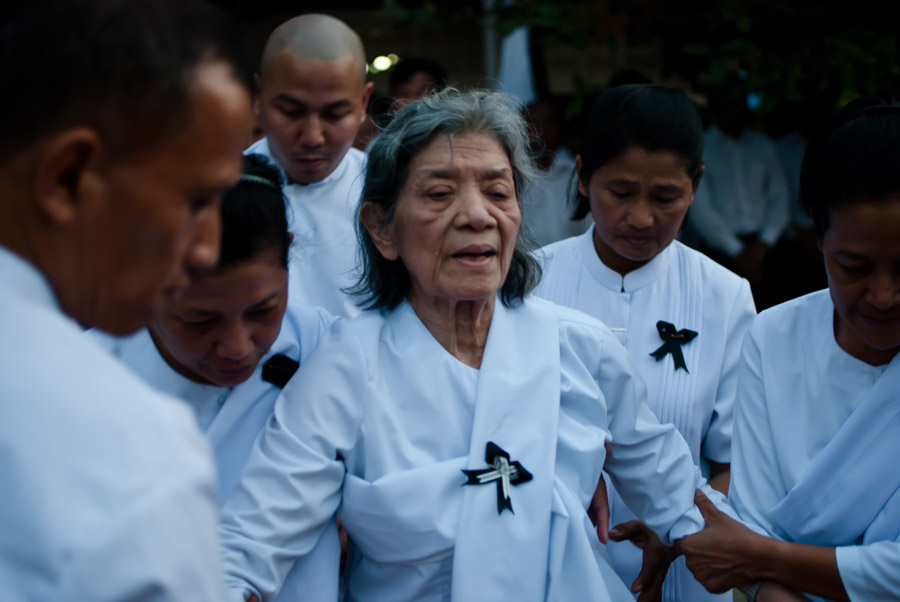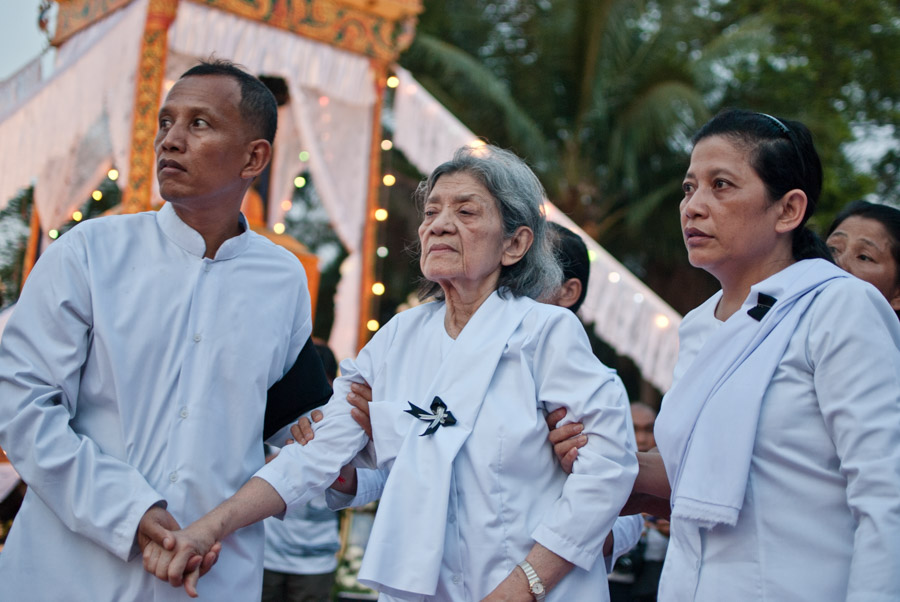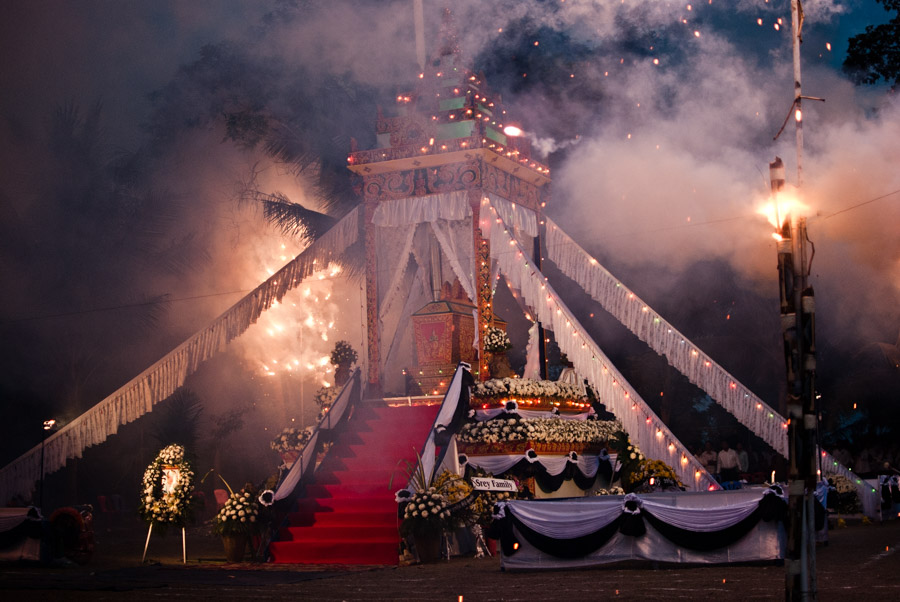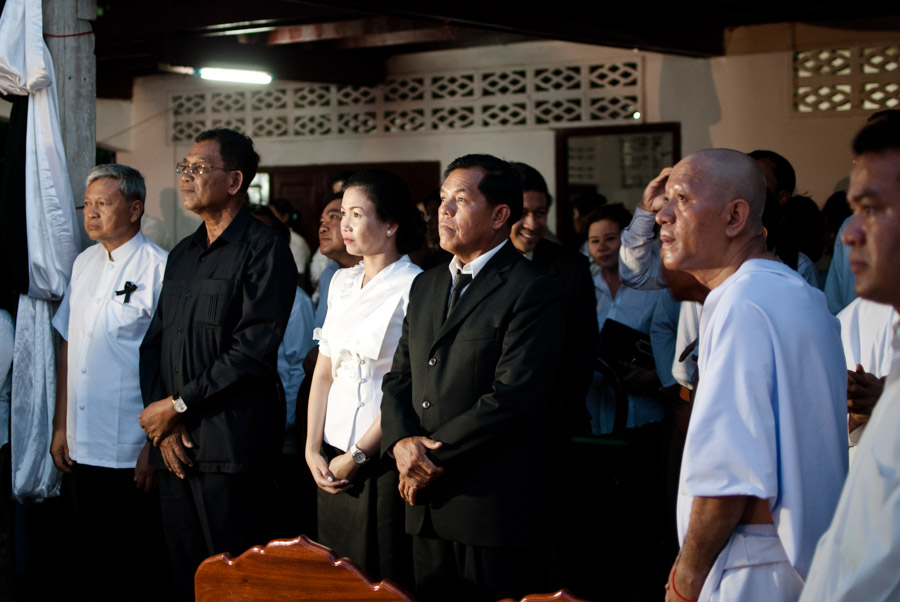
A verdict was never reached in Ieng Sary’s human rights abuses case. His story reveals the limitations of international tribunals.
It was the sort of send-off his own regime would never have permitted: an elaborate Buddhist funeral that ended with prayers, reminiscences, and the crackle of fireworks in an inky night sky. Ieng Sary, one of the last surviving leaders of Cambodia’s murderous Khmer Rouge regime, died of a heart attack on March 14, at the age of 87. For a week afterward, hundreds of white-clad mourners turned out in this former communist stronghold to pay their last respects to a man they remembered as a comrade and patriot–a man who thought only of his nation.
To everyone else, Ieng Sary enjoys the dubious distinction of being the only person to be tried for genocide on two occasions: first in 1979, shortly after the Khmer Rouge fell from power, and then more recently at a UN-backed tribunal in the Cambodian capital Phnom Penh. By dying in the dock, he escaped justice for his role in the Khmer Rouge regime, which ruled Cambodia from 1975 to 1979. Led by “Brother Number One” Pol Pot, the Khmer Rouge conducted a hellish communist experiment — a “super great leap forward” that killed an estimated 1.7 million Cambodians and sowed a green land with hundreds of mass graves.
But that’s not how Sary is remembered in this forgotten corner of the country, a stronghold of the Khmer Rouge until the mid-1990s. On the day of his funeral, monks chanted as wartime comrades and sun-cured farmers arrived at Sary’s country villa to pay their respects. Wreaths of flowers surrounded his gold casket, which sat alongside a jasmine-fringed photo of the former leader. Later the casket was moved into an elaborate two-story crematorium festooned with blinking lights. During a 10-minute eulogy, Sary’s daughter Hun Vanny made just one reference to his involvement with the Khmer Rouge, a period when “he sacrificed his life by leaving his wife and family, moving from place to place.”
“Cambodians talk about the purity of water, purity of gold, purity of silver,” she said of her father. “None of these can compare with the purity of heart.”
Also paying a final farewell was Sary’s frail widow and fellow defendant Ieng Thirith, who was led to the base of crematorium before being bungled into a van and driven away. Thirith served as the Social Affairs Minister under the Khmer Rouge and was also on trial until her release in September, when the court ruled she was unfit to stand trial due to dementia. As Sary’s body burned and fireworks flowered overhead, old comrades reminisced about a boss who fought to free his country from foreign domination. “Ieng Sary, Khieu Samphan and Pol Pot were not communist people–they were liberators,” said 58-year-old Chan Sary, a former Khmer Rouge soldier who lost a leg to a landmine in 1990. “At the top they didn’t know the hardships,” he added, leaning on his crutch.
Ieng Sary enjoys the dubious distinction of being the only person to be tried for genocide on two occasions.
This is not the story historians usually tell. When the Khmer Rouge took power in April 1975, toppling a U.S.-backed republic, they treated Cambodia’s people as an expendable raw material with which they planned to forge a rural utopia of unsurpassed purity, an agrarian dream-state whose name would “be written in golden letters in world history.” Money was abolished, the cities were emptied, and the entire population put to work on vast rural communes. Sary was one of the six members of the Standing Committee of the Communist Party of Kampuchea (CPK)–the nerve-center of the regime. Appointed foreign minister of “Democratic Kampuchea” — as the new regime euphemized itself — Sary issued calls for sympathetic Cambodian intellectuals to return to reconstruct a land destroyed by five years of civil war. Of the 1,000 or so who returned, most were jailed, executed, or perished from starvation or disease.
Many years later Sary would deny any involvement in Khmer Rouge atrocities, but experts have little doubt there was enough evidence to convict him. In 2001, Steve Heder, a leading historian of the period, concluded in a paper co-authored with the legal scholar Brian D. Tittemore that arrest and execution orders routinely crossed Ieng Sary’s desk. They concluded there was “significant evidence of Ieng Sary’s individual responsibility for CPK crimes, for repeatedly and publicly encouraging arrests and executions within his Foreign Ministry and throughout Democratic Kampuchea.”
Ieng Sary was the most slippery of the Khmer Rouge leaders–a master dissimulator who easily shed old revolutionary convictions and adopted new guises. He was “a devious manipulative man, crafty rather than clever,” wrote Philip Short in his book Pol Pot: Anatomy of a Nightmare. “He concealed insincerity beneath a calculated ability to make himself agreeable.” Unlike his austere comrades, Sary was also a revolutionary with a taste for the finer things, such as lobster thermidor, cognac, and French perfume, which he enjoyed during years of starvation and civil war. “When he dropped his normally radiant smile, [it was clear] how dark and harsh his face could become,”wrote James Pringle, a former Reuters correspondent who first met Sary in China in 1971. “I would hate to have faced him across an interrogation table.”
After the Khmer Rouge was overthrown by a Vietnamese invasion in January 1979, Sary and his colleagues fled to the Thai border, where they re-established themselves in jungle bases and, with Chinese and Western support, waged war on the new Vietnam-backed government that had replaced them. Sary, now in charge of the movement’s finances, installed himself in Pailin, a dusty boomtown surrounded by rich gem and timber deposits. By the 1990s he had grown rich — much richer than his austere revolutionary colleagues. Khieu Samphan and Nuon Chea, the two remaining defendants at Cambodia’s war crimes court, did not profit from their careers. Pol Pot died, defeated and penniless, in 1998.
In August 1996, Sary defected to the government in return for a royal amnesty that quashed a death penalty handed down by a Phnom Penh tribunal in 1979. Sary and his wife lived a comfortable life in a shady villa in central Phnom Penh, jetting off to Thailand regularly for medical treatment. Justice finally caught up with the pair in November 2007, when they were arrested and charged with crimes against humanity. It was a heady moment: Nearly 30 years after the Khmer Rouge fell from power, there was a hope that at last justice would be done.
But Ieng Sary’s death mid-trial is a major setback for Cambodia’s war crimes court, known officially as the Extraordinary Chambers in the Courts of Cambodia. After six years and more than $150 million, the tribunal has secured just one conviction–that of Comrade Duch, a former school teacher who was sentenced to life in prison for his role in running S-21, a grisly security center where he oversaw the interrogation and torture of as many as 15,000 people.
The two remaining defendants in the court’s second case, known as Case 002, are also frail and in uncertain health: 86-year-old Nuon Chea, the Khmer Rouge’s chief ideologue and “Brother Number Two” to Pol Pot, has been in and out of hospital and was reported earlier this year to be “approaching death.” Khieu Samphan, the regime’s former head of state, is 81. Peter Maguire, the author of Facing Death in Cambodia, compared Sary’s death to that of the Serbian leader Slobodan Milosevic, who died in 2006 while on trial at The Hague, and argued that both tribunals allowed themselves to become mired in legal minutiae. “This is typical of the UN’s post-Cold War war-crimes trials,” he said. “Like the Milosevic case, there is no urgency.”
Sary’s death has heightened the contradictions of a tribunal process that has always struggled to reconcile the irreconcilable: to map the abstractions of international criminal law onto the social and political realities of contemporary Cambodia.
The court has also been dogged by allegations of political interference in connection with two possible future cases, Case 003 and Case 004, involving five more senior regime figures. Cambodia’s Prime Minister Hun Sen, himself a former mid-ranking Khmer Rouge commander who defected to Vietnam in 1977, has ruled Cambodia in various coalitions since 1985, and retains a strong grip over the domestic courts. In October 2010 he told visiting UN Secretary General Ban Ki-moon that more trials at the ECCC–a hybrid court composed of local and international judges–would not be “allowed.” Because of these two impediments, the Open Society Justice Initiative (OSJI), a court-monitoring group, said last week that “it remains doubtful that the ECCC will successfully complete its current caseload and make a positive contribution to ending impunity and increasing respect for the rule of law in Cambodia.”
But the problem runs deeper. In some ways Sary’s death has heightened the contradictions of a tribunal process that has always struggled to reconcile the irreconcilable: to map the abstractions of international criminal law onto the social and political realities of contemporary Cambodia–a post-conflict country with virtually no history of independent courts. This gulf was illustrated shortly after Sary’s death, when the London-based human rights group Amnesty International issued a statement urging the expedition of the trials. “Ieng Sary should not be presumed guilty of the crimes alleged,” it said, “as the proceedings against him were not completed and there has been no verdict.” In legal terms this was exactly correct, but how just or moral was it? The ECCC was explicitly established with the victims in mind, and was the first tribunal of its kind to invite participation from civil parties representing those who suffered under the Khmer Rouge. How much solace were victims expected to take in the fact that the legal procedures had been followed, and that a man whose crimes are well attested by the historical record had gone to his grave–as many will no doubt interpret it–“not guilty?”
It showed, above all, that Cambodia remains a long way from The Hague. Sary’s death, like Milosevic’s before it, demonstrates that one of the saving ideas of our times–the hope that international criminal tribunals can punish atrocities, deter warlords and provide closure for victims–remains burdened by serious limitations. “Cambodia is a complex, mostly Buddhist country,” said Maguire. “The idea that Western outsiders can transplant Western modes of conflict resolution is incredibly naïve.”
And yet, this may be the closest Cambodia gets to accountability for the horrors perpetuated by the Khmer Rouge. Youk Chhang, the director of the Documentation Center of Cambodia, which researches Khmer Rouge history, said that now that the court was in motion it had no option but to continue its work. “The court must move on,” he said. “The UN and the Cambodian government made a promise to punish the perpetrators of genocide. The victims deserve closure. The victims deserve to see the process completed.”
Ieng Sary’s victims will have to make do with the verdict of history — but that may well prove the more enduring.
[Published at TheAtlantic.com, April 1, 2013]

